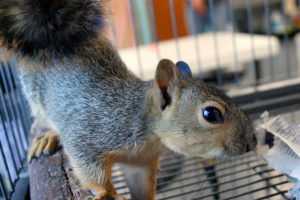A Squirrel for All Seasons
Spring and fall are busiest times for baby squirrels

Eastern fox squirrels are one of the most common species of animals admitted to California Wildlife Center. CWC’s Baby Care Unit also cares for large numbers of orphaned song-birds, opossums, hummingbirds, and crows.
By Executive Director Jennifer Brent
Last year, California Wildlife Center received 486 Eastern Fox Squirrels and so far this year, we have received 414. They are the species that we see the most at CWC (second most common is the Mallard).
Why so many? Some have had negative contacts with people – shot by a BB gun, struck by a vehicle or caught by a pet. However, the vast majority we receive are babies (called kittens) and have fallen from trees of have otherwise been separated from their mothers. This may occur if a tree is trimmed during squirrel nesting season (February-April and August-October) or if the baby falls from a nest and it’s too dangerous for the mother to go down and retrieve him.
When baby squirrels are found on the ground, they should be observed from afar (as long as they are not in direct danger) to make sure that the mother picks him up. If, after 3 hours, there are no signs of a mother coming, the squirrel can be picked up and put into a dark, quiet box with a small towel or blanket for warmth and brought to CWC.
Baby squirrels are fed a warmed species appropriate formula that mimics mother’s milk. When very young, they are fed four times a day. Once they are old enough to be fed just three times a day, they are put together into social groups of four to seven squirrels who will act as surrogate siblings and eventually be released together. A diet of nuts, berries and vegetables are introduced and, over time, this combination completely replaces the milk formula. As with all rodents, squirrel’s front teeth grow continually so at CWC, they are given appropriate material such as pine cones and branches to keep them healthy.
Eventually the squirrels are self-feeding and are transferred from CWC’s Baby Care Unit to outdoor enclosures. These allow them to move more freely and decreases any habituation that the squirrels developed while constantly being around people in the Baby Care Unit. After about a month in the outdoor enclosures, they are released in their same social unit back into the wilderness. The average length of stay for a baby squirrel is three months at CWC.
